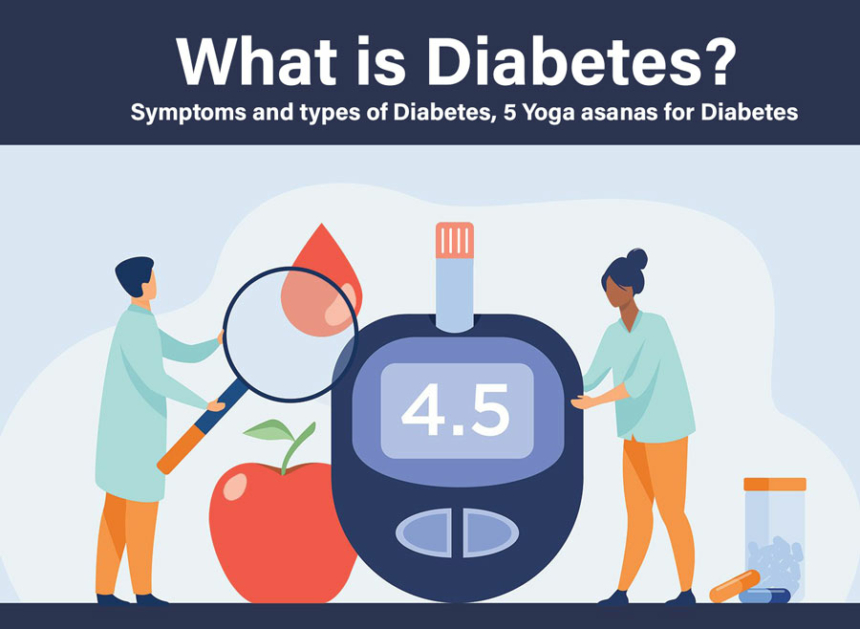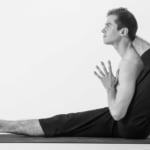What is Diabetes? Symptoms and types of Diabetes, 5 Yoga asanas for Diabetes
By Himanshu JoshiYogaDiabetes, one of the fastest growing chronic diseases in the world, has become a top health concern for people around the world. From sedentary or inactive lifestyle, faulty food habits, to family history, the disease could trigger due to any of the reasons. If not controlled, it could lead to kidney failure, blindness, lower leg amputation apart from several other complications.
Diabetes has been growing at an alarming rate and in the last 20 years, the people affected by it have doubled. While the age group of 45-64 has been among the most affected, the disease is seen among younger lot too owing to lifestyle and other factors. Coronavirus pandemic has further brought the spotlight to Diabetes as people with the disease have higher risk of developing complications and having a severe illness from Covid-19 compared to people who do not have this disease. Following a healthy lifestyle with physical activity, exercise, and diet modifications could reduce Diabetes risk among people.
Learn More
- 10 Great Healthy Benefits of Doing Yoga Everyday to Your Body and Mind
- 10 Yoga Poses That Will Bring Full Body Strength & Balance
- 10 Simple & Effective Yoga Asanas For Men And Women
- What is Depression? Symptoms, Causes, Types, Treatment
- Yoga for Asthma: Symptoms, Causes, How to cure? How yoga helps and poses to try
What is Diabetes
In Diabetes our body doesn’t make enough insulin or can’t use the insulin effectively. When we eat, our digestive system breaks down the food and the sugar is released in the bloodstream. The role of insulin comes into play here, as it helps the body to use this sugar effectively. When the body can’t make insulin or is not able to use it properly, the blood sugar being unmanaged remains in the bloodstream and could lead to several health problems.
Types of Diabetes
Diabetes is mainly categorized as Type 1 Diabetes and Type 2 Diabetes. In the first type, the body stops making insulin and you have to take it externally every day. The Type 1 Diabetes happens due to body’s autoimmune response where it starts attacking healthy cells because of which the insulin production stops. It is also seen in children, teenagers or young adults. Most of the people however would develop Type 2 Diabetes where either the body can’t make enough insulin or can’t use it properly. More than 90% of the people who develop Diabetes fall in the category of Type 2 Diabetes.
Gestational Diabetes is another kind that affects pregnant women with no history of Diabetes. This gets cured on its own after delivery, but women who are diagnosed with gestational diabetes go on to develop type 2 Diabetes later in their life. The baby also has a risk of developing type 2 diabetes.
Symptoms of Diabetes
Frequent urination: You may feel the urge to use the washroom more than a couple of times, apparently due to increased glucose levels in your blood that force fluids from your cells. This means more liquid is accumulated in your kidneys which results in a need to empty your bladder.
Feeling thirsty: When you are urinating frequently, your body is bound to get dehydrated at some point of time which could make you feel thirsty constantly.
Weight loss: When body doesn’t produce insulin the way it should, the glucose in the blood is not passed on to body cells to be used as energy. As a result, body starts utilizing fat and muscles for energy which results in weight loss.
Fatigue: Diabetics often feel fatigue for a number of reasons, one of them being insulin resistance due to which body doesn’t meet its energy needs or due to strong medication which could lower their glucose levels.
Numb or tingling sensation in hand or feet: The tingling sensation in your hand and feet could be due to diabetic neuropathy which could cause damage to the nerves and the tingling sensation is due to that.
Blurry vision: Diabetes can affect your eyes both in short and long term. In long term, diabetes may affect retina due to damage in blood vessels while in short term, fluid can move in and out due to high sugar levels. Very low sugar levels could also affect your vision.
Dry skin: Dry skin is quite common in diabetics due to high blood sugar levels.
Slow healing of sores: Diabetes can also affect the functioning of your immune system that is also responsible for healing.
Symptoms of Type 1 Diabetes
Type 1 Diabetes symptoms develop very fast and can be severe. It can start when you are a child or a teenager. People with Type 1 Diabetes may complain of nausea, vomiting or stomach pains.
Symptoms of Type 2 Diabetes
Symptoms of Type 2 Diabetes develop slowly over a period of time and people may not notice them immediately. While it mostly affects adults who have family history, it is nowadays seen in even children and young adults more frequently than before.
Symptoms of Gestational Diabetes
This doesn’t have any symptoms and gets diagnosed when a blood glucose test is conducted between 24 and 28 weeks of pregnancy.
Diabetes management
Diabetes can be managed by medication, modifying diet and making certain lifestyle changes. Before your diabetes diagnosis if you were inactive and leading an sedentary lifestyle, you are advised to make changes and incorporate certain exercises and avoid certain foods that increase your sugar level fast.
Is it possible to reverse diabetes?
If you have prediabetes, which means that your sugar levels are high but not enough to qualify as type 2 diabetes. At this stage, if you make lifestyle changes and include physical activity in your daily routine and consume foods with low Glycemic Index (GI), lose weight and sleep well, you may reverse the condition.
Yoga for Diabetes
Yoga has been increasingly trusted as an adjunct therapy in treatment of many diseases and diabetes is no exception. It is possible to reverse diabetes at earlier stages or when one has prediabetes by a set of changes. Yoga, an ancient practice, helps to connect breath, mind and body for overall wellness. There are many yoga postures that could bring relief in chronic illnesses, improve mental health, digestion, flexibility and strength.
As far as diabetes is concerned, several studies vouch for yoga’s effectiveness in controlling stress-related hyperglycemia and its ability to control blood sugar levels. Certain yoga poses could improve the production of insulin in the body with their positive effect on pancreas, while many others promote weight loss, which could help in reversal of diabetes.
Yoga asanas and Pranayama for Diabetes
Dhanurasana
Dhanurasana or bow pose is all about strength as it not only improves posture but strengthens pancreas which is extremely beneficial for a Diabetes patient.
Looking like bow in the final pose, Dhanurashana strengthens back and abdominal muscles. It makes legs, arms, thighs, neck and hips more flexible.
Dhanurasana opens up shoulder blades, chest, neck and stretches the entire front body. It works on ankles, thighs, groins, abdomen and throat. The asana is also quite helpful in reducing belly fat and waist fat.
Steps
- Lie on your stomach
- Keep your feet apart and arms by side of your body
- Fold your knees. Hold your ankles by taking your hands backwards
- Lift your chest and pull your legs up, towards the back
- Look straight
- Your body now resembles shape of a bow
- Hold the asana for a while
- Do not overdo the stretch.
- Precautions
- People with slipped disc or spinal cord issues should not practice this asana
- If you have stomach issues, consult an experienced teacher before attempting the pose
Kapalbhati
Kapalbhati helps purify ida and pingala nadis and activates mind that helps one shun lethargy and go about the day in an energetic way. To practice this technique, sit in a comfortable position and inhale through both your nostrils as the abdomen expands naturally. Exhale with a quick contraction of the abdominal muscles but do not strain. Do five rounds of passive inhalation and forceful exhalation in the beginning, while remembering not to apply too much pressure. After completing the rounds, bring your focus between your eyes and feel the calm spreading inside. It is recommended that Kapalbhati must be practiced after asanas or neti and before pratyahara and dharana technique.
Shavasana
Shavasana or a corpse pose means bringing your body to such a deep state of rest that it resembles a corpse. The pose has immense recuperative benefits and refreshes the mind and body like no other pose does. By reducing stress and activating the repair of tissues and cells, a diabetic gets immensely benefitted by this pose.
Steps
- Lie on your back and let your body comfortable and loose
- Your legs, feet, knees, back should be completely relaxed with no tension in muscles
- Arms should be kept on the ground with palms facing upwards.
- Take few deep breaths and bring your attention to each part of the body staring from your toes
- Move your attention slowly up to foot, knees, thighs, back, shoulders as you progress with the asana, trying to loosen up your muscles in each part of the body as much as you can
- The body should feel light like a feather
- When you feel your entire body has been relaxed, slowly come out of the asana
Paschimottanasana
Paschimottanasana or seated forward bend works on abdominal muscles and pelvic organs which is beneficial for diabetics. It also helps stretch lower back, hamstrings and hips.
Besides, the asana also helps relax mind and body which works wonderfully for diabetes patients.
Steps
- Sit comfortably on your yoga mat and stretch your feet forward and spine erect
- Breathe in and raise your arms upward
- Exhale and bend forward at the hip while moving your upper body towards your toes
- Lower your arms and grip your big toes with your fingers.
- Try to touch your knees with your nose.
- Hold the posture for a few seconds
Halasana
Hala in Sanskrit means plough. Considering our body resembles a plough in the final pose, the asana is named so. When you do Halasana your abdomen muscles get compressed which activates the pancreas, the organ which helps in managing diabetes. It is also good for your nervous system and improves concentration and memory. . It alleviates tightness in shoulders and neck. As joints in legs, shoulders, arms and spine get flexibility Halasana enhances mobility. It stimulates abdominal organs and thyroid. For mental well being it works very well and calms the mind. Among other multiple benefits it also reduces high blood pressure and clears the respiratory system of mucus.
Steps
- Lie on your back
- Keep your arms sideways
- Bring your legs together and palms should face downwards
- Now lift your legs up till they are perpendicular to the floor
- With the help of your arms pressing against the floor, raise your buttocks and move your toes to touch the ground over your head
- If your feet are not able to touch the ground, don’t force the movement
- Bring your arms closer and try to entwine fingers of both hands together
- Bring your chin at the centre of the collar bone
- Hold the pose for as long as you are comfortable
- Slowly release the pose
Precautions
- Avoid doing Halasana in case of slipped disc or pain or injury in back or neck.
- Halasana should also be avoided when you have hernia, sciatica, enlarged thyroid, spleen or liver.
- Patients with cervical or heart problems must not do this asana.
- If you have constant headaches, avoid this pose.
- Halasana should not be practiced during pregnancy or while menstruation.






